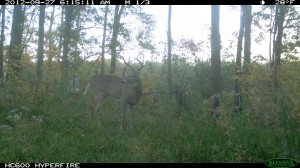Clover is a work horse in food plots for deer
Clover is a work horse in food plots for deer
I did a variation of a post like this last year, showing how I often let the weeds go on smaller bean plots until the soybeans have become established enough to both canopy the ground and withstand deer browse far better. This year, I’ll show a virtually guaranteed way to establish clover plots.
The first thing I need to point out is that I can’t remember the last time I broke ground to plant clover, despite having somewhere over 30 clover plots going every year. For what I do, clover is a real workhorse and time saver. About half the plots I don’t bother cutting each year (I only cut clover to control weeds and only do so when they are really getting out of hand), I spray around half of them for grass each year (grass is an enemy, where as weeds generally aren’t a horrible thing) and can get 5-10 years out of clover plots, so long as I frost seed every other year or so to fill in dead spots &/or thin areas. Add it all up and it is about the cheapest, lowest effort food plots I put in, while offering great nutrition for around 8 months a year in the northern states and 10-12 months in the Midwest.
Clover is a work horse in food plots for deer
The other way I use clover is to create a 10 yard wide ring around many other plantings (brassicas, corn, beans, peas) where they are edged by brush and trees. Many plantings don’t do well close to trees and brush, due to their shade and nutrient and water theft. Clover generally does fine there. So, creating those buffer strips helps keep costs down, while adding another attraction to the plot and creating even more food in often limited space (instead of having corn stalks without cobs, or massively stunted and thin brassicas, peas or beans along the woods, it provides decent-good clover growth).
Clover is a work horse in food plots for deer

One more thing I should point out is that I almost always use Antler King Trophy Clover mix. I know it’s not “cool” to use BOBs (it’s the only straight BOB I use…I also use their Honey Hole (a brassica mix), but I add radishes to that and then far more often than not top seed with 4 parts cereal rye and 1 part oats). I’ve just had consistently great luck with that blend over many, many years and could never match its drought tolerance, germ rates and deer desirability combo in other BOBs or blends I’ve put together myself (and I’ve tried hard).
That said, use whatever you want for clover. The approach I use has worked with any clover combo I’ve tried. In fact, the real reason I mention the brand is because it contains rape as a 1st year cover crop. Not only will that show up in a pic below, but it also serves to dispel that you can’t frost seed brassicas, as some frost seed very well, and shows that doing so can give the tonnage your plot produces a huge boost and it serves as a great cover crop for clover that first year.
With all that out of the way, frost seeding is a thing of pure beauty and, so long as you have seed to soil contact, is the closest to a guaranteed thriving clover plot as it gets. As mentioned to begin this post, I just don’t break ground for planting clover anymore at all. I merely apply the clover at about 125% the suggested rate, when frost seeding the first time.
Clover is a work horse in food plots for deer
Each time I establish clover, I’m either doing so in an in-woods plot I cleared that winter with a dozer or somewhere that I’d had in other annual crops (brassicas, corn, beans, peas, oats, cereal rye or a combo of those plantings) the fall before. When following annual plots, that gives me a chance to work in lime, assuming it’s required, the year before. If it calls for more than 2.5 tons per acre, I’ll do 2.5 tone before planting the annual and apply the rest, up to 2.5 tons, after frost seeding/before the final spring thaw (if at all possible). On plots without breaking ground, I just apply before the last thaw and then repeat in late summer, if needed.

Clover is a work horse in food plots for deer
I only mow if I absolutely have to that first year. I don’t want to stress the clover by mowing or setback the rape’s production (it can handle high mowings, but it does impact production). I want it to use that first year for the individual plants to establish robust root systems and also produce as much of its own seed as practically possible, all while minimizing the amount of dirt directly exposed to the sun. Sure, the weed competition places somewhat of a stress on the rape and clover, but nothing compared to mowings and baked dirt. Also, many weeds provide feed for the deer and also can help protect the young clover and rape growth from deer browse.
Now, that said, going into fall, if the weeds are really thick and considerably higher than the clover and rape, that can hinder feeding. One can either mow high (8-12″) or simply drag over the plot. If I feel I have to do that (maybe 10-20% of all plots I feel I have to, at most), I let the quality of rape determine whether I mow or drag. If the rape has already been decimated by the deer (which happens to me more often on the in-woods plots), I’ll drag with a log or section of chain link. In that case, all I’m trying to do is lay the weeds down. A cultipacker will inflict more damage on the clover.
Grass is another story. Though weeds seldom are thick enough to choke out clover or rape, grass can be. If that looks like it may be an issue, I won’t hesitate to spray for grass.
From the second year on out, all I typically do for maintenance is mow if the weeds are thick and spray to control grass, if they look like they may become an issue. I’ll also fertilize with a 0-0-## (40 to 60) at 200 lbs an acre, right before a predicted heavy rain if the plot isn’t producing the growth rates I want. If on sandy soil, I’ll test for pH every couple years, every 4-5 on heavier soils, and top spread lime when required. Finally, when the stand is getting thin or there are bare spots, I’ll frost seed more clover the following year (about a 50% rate is thin, 125% on bare areas).
If you’re happy with your clover plots, by all means keep doing what you are doing. If not, give this a try. It’s the most fool proof method I’ve found. I honestly can’t even remember the last time I’ve been disappointed in a new clover plot, when using this method (and I use this method 5-15 times every year)…and it’s a lot cheaper/less time intensive than planting buckwheat a couple times over spring/summer to control weed growth for a fall planting of clover, with a cereal rye cover crop.
Pic 1 shows what a typical in-woods plot looks like when done clearing it with a dozer
Pic 2 shows the clover in the same plot in August (in IL)
Pic 3 is a bigger pic of the same plot, showing what I mean by “weeds getting bad”
Pic 4 shows what it looks like after dragging it, knocking the weeds down to give the clover a jump on being even more established by fall/increasing the feeding even more, now that it can handle it (the deer wiped out what was a great germ rate on the rape, as happens more often in in-woods plots for me)
Pic 5 shows what I typically get for rape production using this method when frost seeding into last year’s annuals (that pic was taken around Sept 5th in WI….look at that tonnage of winter forage that rape produced!)


